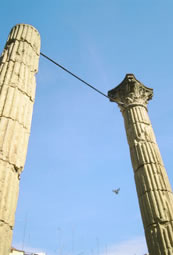
Romanesque Heritage
Romanesque art is the first one which can be defined as a purely Catalan art. It was born in the Pyrenees, like the first Catalan counties, and it ended up its expansion in the meridional and western borders of Catalonia. We can not forget that from the Pyrenees, at the end of the 8th century, the frank sovereigns organized a Hispanic Mark or barrier among theirs rules and the Arab world; and Lleida and Tortosa were conquered in the middle of the 12th century organizing themselves along the following generations. Among these limits, the Romanesque is practically placed: from the year 1000 until the end of the 13th century.The Romanesque is strongly tied to the formation and expansion of the medieval Catalonia, and because of that its evolution is linked to the historical events. The change of millenium brought the end of the Muslim danger and, soon, the fastening of the ‘taifas’ kingdoms to the protection of the Catalan counts. The count dynasties became strong thanks to the hegemony of the county of Barcelona and the great viscount and stately lineages, which wanted to emulate the earls in the construction of churches and monasteries often as family pantheons, started to be outlined. It is also the moment in what the feudal system gets strong and the country experiments a good economical stage that favored the circulation of money of gold and, consequently, the raising of new buildings that adapted formulas and methods of foreign construction.
The main influences of the Catalan Romanesque came from the Lombardia in architecture and the Provenza and Tolosa schools in sculpture. However, their characteristics adopted here a different use and arrangement of the stone, the openings and the cover of big surfaces with ‘volta de canó’, so that is why we can speak about the Catalan Romanesque, which is distinguished from neighboring regions. The used stone has a small size and it is not very polished, with big covered spaces, little ornamentation and all the variety of archs.
All the set of ornamental and daily elements, which complemented and adorned the religious and civil buildings of this stage, can be admired in the demarcation of the Costa Daurada. Castles, bridges, architectural complexs like the Carthusian Monastery of Escaladei and Romanesque churches, are distributed among more than forty villages. They are the historical and architectural witnesses of the European influence which this territory received and adopted during the XI and XIII centuries.
